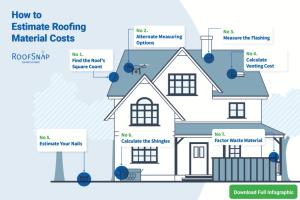Mastering Roofing Material Estimation: Your Comprehensive Guide

-
Quick Links:
- Introduction
- Understanding Different Roof Types
- Essential Tools for Estimating Roofing Materials
- Step-by-Step Estimation Process
- Common Roofing Materials and Their Characteristics
- Case Studies: Real-World Estimation Examples
- Expert Insights on Roofing Estimation
- FAQs
Introduction
Estimating roofing materials is a critical task that can significantly influence the efficiency and cost-effectiveness of a roofing project. Whether you're a DIY enthusiast or a professional contractor, understanding how to accurately estimate the materials needed for your roofing project can save you both time and money. This guide will provide you with a comprehensive understanding of the estimation process, including a breakdown of different roof types, essential tools, and step-by-step instructions.Understanding Different Roof Types
Before diving into the estimation process, it's crucial to understand the various types of roofs and their unique characteristics. This knowledge will help you select the appropriate materials for your project.1. Flat Roofs
Flat roofs are common in commercial buildings and modern homes. They require materials that can withstand water pooling. Common materials include: - EPDM (Ethylene Propylene Diene Monomer) - TPO (Thermoplastic Olefin) - Modified Bitumen2. Pitched Roofs
Pitched roofs are characterized by their steep slope and are prevalent in residential buildings. They typically use: - Asphalt shingles - Metal roofing - Slate tiles3. Gable Roofs
Gable roofs have two sloping sides that meet at the top, forming a triangle. They're popular for their aesthetic appeal and effective water drainage.Essential Tools for Estimating Roofing Materials
Gathering the right tools is the first step in estimating roofing materials accurately. Here are some essential items you will need:- Measuring Tape: For measuring roof dimensions.
- Calculator: To perform necessary calculations.
- Roofing Square: For calculating angles and cuts.
- Roof Pitch Gauge: To measure the slope of the roof.
- Blueprints or Plans: To refer to the design specifications.
Step-by-Step Estimation Process
Estimating roofing materials involves several steps. Follow this detailed guide to ensure accuracy.Step 1: Measure the Roof Area
Start by measuring the length and width of the roof. For gable roofs, measure each side separately. - **Formula for Area:** Area = Length x WidthStep 2: Determine the Roof Pitch
Use a pitch gauge to determine the slope of the roof. The pitch will affect the amount of material needed. - **Pitch Examples:** - 4/12 pitch means 4 inches of rise for every 12 inches of run.Step 3: Calculate Total Square Footage
For roofs that are not flat, you need to adjust for the pitch. - **Formula for Pitched Roof:** Adjusted Area = Area x (1 + (Pitch/12))Step 4: Decide on Material Types
Choose the roofing materials based on your budget and aesthetic preferences. Different materials have different coverage rates.Step 5: Calculate Material Quantities
Based on the type of material chosen, determine how much you will need. For example, asphalt shingles typically cover about 33 square feet per bundle. - **Formula for Bundles Needed:** Bundles = Total Area / Coverage per BundleCommon Roofing Materials and Their Characteristics
Here’s a breakdown of popular roofing materials and their characteristics. | Material Type | Lifespan | Cost per Square | Maintenance | |--------------------|---------------|------------------|------------------| | Asphalt Shingles | 20-30 years | $90 - $100 | Low | | Metal Roofing | 40-70 years | $100 - $200 | Low | | Slate Tiles | 75-200 years | $300 - $600 | High | | TPO Membrane | 20-30 years | $100 - $150 | Medium |Case Studies: Real-World Estimation Examples
Real-world examples can provide insight into the estimation process.Case Study 1: Residential Gable Roof
For a residential gable roof measuring 30 feet by 40 feet with a 6/12 pitch, the estimation process would follow these steps: - Calculate area = 30 ft x 40 ft = 1200 sq ft - Adjust for pitch = 1200 x 1.083 = 1299.6 sq ft - Determine bundles needed for asphalt shingles = 1299.6 / 33 = 39.4 bundles, round up to 40 bundles.Case Study 2: Commercial Flat Roof
In a commercial flat roof scenario measuring 50 feet by 100 feet: - Calculate area = 50 ft x 100 ft = 5000 sq ft - For TPO membrane, coverage is around 200 sq ft per roll. - Rolls needed = 5000 / 200 = 25 rolls.Expert Insights on Roofing Estimation
We reached out to industry experts for their insights on common pitfalls in roofing material estimation. - **Expert Tip 1:** Always account for waste—typically around 10% for shingles and 5% for metal roofing. - **Expert Tip 2:** Consult local building codes and regulations as they may dictate specific material choices.FAQs
1. What tools do I need for estimating roofing materials?
You need a measuring tape, calculator, roofing square, pitch gauge, and blueprints.
2. How do I calculate the area of my roof?
Measure the length and width and multiply them together. Adjust for the pitch if necessary.
3. What is the most cost-effective roofing material?
Asphalt shingles are generally the most cost-effective option for residential roofs.
4. How much waste should I account for in my estimates?
Plan for about 10% waste for shingles and 5% for metal roofing.
5. What is the lifespan of different roofing materials?
Lifespan varies: asphalt shingles last 20-30 years, metal roofs 40-70 years, and slate tiles can last over 100 years.
6. How do I measure roof pitch?
Use a pitch gauge or measure the rise over a 12-inch run.
7. Can I estimate roofing materials myself?
Yes, with the right tools and knowledge, you can estimate materials accurately.
8. What types of roofing are best for high rainfall areas?
Metal roofing and slate tiles are excellent choices for high rainfall due to their durability and water resistance.
9. How do I choose the right roofing material?
Consider factors like climate, cost, aesthetic preference, and longevity.
10. Where can I find roofing material prices?
Check local suppliers, home improvement stores, and online marketplaces for current pricing.
Random Reads